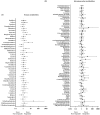Metabolic Predictors of Cardiorespiratory Fitness Responsiveness to Continuous Endurance and High-Intensity Interval Training Programs: The TIMES Study-A Randomized Controlled Trial
- PMID: 39330519
- PMCID: PMC11433752
- DOI: 10.3390/metabo14090512
Metabolic Predictors of Cardiorespiratory Fitness Responsiveness to Continuous Endurance and High-Intensity Interval Training Programs: The TIMES Study-A Randomized Controlled Trial
Abstract
Background/Objectives: Cardiorespiratory fitness (CRF) levels significantly modulate the risk of cardiometabolic diseases, aging, and mortality. Nevertheless, there is a substantial interindividual variability in CRF responsiveness to a given standardized exercise dose despite the type of training. Predicting the responsiveness to regular exercise has the potential to contribute to personalized exercise medicine applications. This study aimed to identify predictive biomarkers for the classification of CRF responsiveness based on serum and intramuscular metabolic levels before continuous endurance training (ET) or high-intensity interval training (HIIT) programs using a randomized controlled trial. Methods: Forty-three serum and seventy intramuscular (vastus lateralis) metabolites were characterized and quantified via proton nuclear magnetic resonance (1H NMR), and CRF levels (expressed in METs) were measured in 70 sedentary young men (age: 23.7 ± 3.0 years; BMI: 24.8 ± 2.5 kg·m-2), at baseline and post 8 weeks of the ET, HIIT, and control (CO) periods. A multivariate binary logistic regression model was used to classify individuals at baseline as Responders or Non-responders to CRF gains after the training programs. Results: CRF responses ranged from 0.9 to 3.9 METs for ET, 1.1 to 4.7 METs for HIIT, and -0.9 to 0.2 METs for CO. The frequency of Responder/Non-responder individuals between ET (76.7%/23.3%) and HIIT (90.0%/10.0%) programs was similar (p = 0.166). The model based on serum O-acetylcarnitine levels [OR (odds ratio) = 4.72, p = 0.012] classified Responder/Non-responders individuals to changes in CRF regardless of the training program with 78.0% accuracy (p = 0.006), while the intramuscular model based on creatinine levels (OR = 4.53, p = 0.0137) presented 72.3% accuracy (p = 0.028). Conclusions: These results highlight the potential value of serum and intramuscular metabolites as biomarkers for the classification of CRF responsiveness previous to different aerobic training programs.
Keywords: NMR; endurance training; high-intensity interval training; metabolomics; trainability.
Conflict of interest statement
The authors declare no conflicts of interest.
Figures





Similar articles
-
Association Between Changes in Serum and Skeletal Muscle Metabolomics Profile With Maximum Power Output Gains in Response to Different Aerobic Training Programs: The Times Study.Front Physiol. 2021 Oct 20;12:756618. doi: 10.3389/fphys.2021.756618. eCollection 2021. Front Physiol. 2021. PMID: 34744794 Free PMC article.
-
Association of skeletal muscle and serum metabolites with maximum power output gains in response to continuous endurance or high-intensity interval training programs: The TIMES study - A randomized controlled trial.PLoS One. 2019 Feb 11;14(2):e0212115. doi: 10.1371/journal.pone.0212115. eCollection 2019. PLoS One. 2019. PMID: 30742692 Free PMC article. Clinical Trial.
-
Training responsiveness of cardiorespiratory fitness and arterial stiffness following moderate-intensity continuous training and high-intensity interval training in adults with intellectual and developmental disabilities.J Intellect Disabil Res. 2021 Dec;65(12):1058-1072. doi: 10.1111/jir.12894. Epub 2021 Oct 28. J Intellect Disabil Res. 2021. PMID: 34713518
-
Is low-volume high-intensity interval training a time-efficient strategy to improve cardiometabolic health and body composition? A meta-analysis.Appl Physiol Nutr Metab. 2024 Mar 1;49(3):273-292. doi: 10.1139/apnm-2023-0329. Epub 2023 Nov 8. Appl Physiol Nutr Metab. 2024. PMID: 37939367 Review.
-
Effects of High-Intensity Interval Training on the Parameters Related to Physical Fitness and Health of Older Adults: A Systematic Review and Meta-Analysis.Sports Med Open. 2024 Sep 12;10(1):98. doi: 10.1186/s40798-024-00767-9. Sports Med Open. 2024. PMID: 39266933 Free PMC article.
References
-
- GBD 2017 Causes of Death Collaborators Global, Regional, and National Age-Sex-Specific Mortality for 282 Causes of Death in 195 Countries and Territories, 1980–2017: A Systematic Analysis for the Global Burden of Disease Study 2017. Lancet. 2018;392:1736–1788. doi: 10.1016/S0140-6736(18)32203-7. - DOI - PMC - PubMed
-
- American College of Sports Medicine (ACSM) ACSM’s Guidelines for Exercise Testing and Prescription, 11th ed. Wolters Kluwer; Philadelphia, PA, USA: 2022.
-
- Bull F.C., Al-Ansari S.S., Biddle S., Borodulin K., Buman M.P., Cardon G., Carty C., Chaput J.-P., Chastin S., Chou R., et al. World Health Organization 2020 Guidelines on Physical Activity and Sedentary Behaviour. Br. J. Sports Med. 2020;54:1451–1462. doi: 10.1136/bjsports-2020-102955. - DOI - PMC - PubMed
Grants and funding
LinkOut - more resources
Full Text Sources

